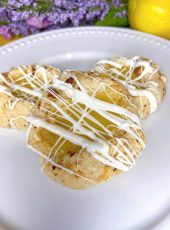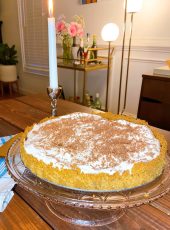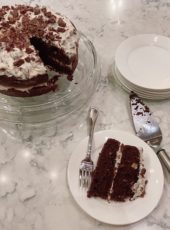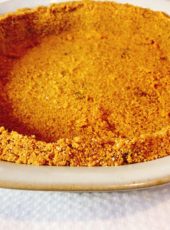From the 1975 printing of “Betty Crocker’s Cookbook,” this classic pastry recipe uses vegetable shortening to produce a light, flaky backdrop for any pie.
“Pyes were but indigested lumps of dough
’Till time and just expense improv’d them so”
– a poem from the year 1750
So begins Janet Clarkson’s Pie: A Global History. If you’re like me, you look forward to pie crust just about as much as what’s inside. But as it turns out, for a lot of human culinary history the flakey, golden, deletable exterior of pies was meant to be thrown away. Until relatively recently, it was mostly used to protect what was cooked inside it.
In Europe in the Middle Ages, bread was baked as disks on hot stones in a fire; meat was cooked out in an open flame. Meat shrinks more this way and can dry out – you lose all the drippings while it cooks. A new problem arose – how to create a different cooking process that could capture the valuable drippings? The earliest ovens were kilns, and some innovative person recognizing the similar structure of clay and dough, decided to place dough in the hot kiln – creating the first bread oven. Soon, a primitive meat pie was born – baking meat inside a shell of dough. As Clarkson explains, “everything that wasn’t bread, was ‘pie’. Everything.” For hundreds of years this thick crust was the only form of baking dish. It also acted as a storage container so you could bring food with you, as well as a preservative to keep food longer before refrigeration. These crusts were often called “coffins,” but only because the word meant a “basket” or a “box,” not for any morbid reason.

When does dough become pastry? When fat is added. The American Pie Council – of which I’d be proud to be a member – notes that there’s good evidence that an early idea of pie has existed since 2000 B.C. Ancient Egyptians, Ancient Greeks, and Ancient Romans ate sweets cooked inside something, but the marriage of fruit inside an edible – and delectable on its own – pastry crust didn’t develop until around the 1500’s.
I’ve tried every pie crust you can think of, always imaging there was improvement on the other side. But I’ve always gone back to the one I grew up with my mom making – Betty Crocker’s “Standard Pastry” from her 1975 printing of Betty Crocker’s Cookbook, (the 5-ring binder one, if you know you know), with Crisco in place of lard.
The big 1970’s-reddish-orange cookbook my parents let me have from their kitchen brings me so much comfort. For one thing, when it gets brought out it’s highly likely that pie is in your near future. For another, the idea of Betty Crocker herself gives me comfort, like she’s gently guiding me through the baking process. And I’m not alone. Tori Avey, writing for PBS’ The History Kitchen, describes Betty Crocker as a “kitchen confidante,” the home cooking version of “Dear Abby,” a trusted resources for home cooks, especially young housewives learning the new adult expectations of the kitchen. How dismaying then to learn that she’s nothing more than a figment of advertisers’ imaginations.

Her fictitious persona began when a small all-male advertising department at the Washburn-Crosby Company (a precursor to General Mills) had the task of answering customer questions about baking and cooking. They felt the women writing in might feel more comforted if the person responding with advice was also a woman – and the answers they gleaned came from the women working in staff roles in the office anyhow. They chose the last name Crocker after the recently retired CEO of the company, and the first name Betty because it sounded cheerful and wholesome. They held a competition for her signature, which was won by secretary Florence Lindeberg – and Betty Crocker was born.
In 1924, the company started a cooking show and hired Marjorie Child Husted to be the host of the show – and the voice of Betty Crocker. In 1936, she was made into a portrait based on composite features of the women who worked in the Washburn-Crosby company, which was used for 20 years, and since then her image has been updated seven times. Her famous cake mixes appeared in stores in 1947, her signature logo on products since 1954. In 1945 Fortune Magazine named her the second most popular woman in America, after Eleanor Roosevelt.
Call me naive, but without looking into it I had assumed that Betty Crocker was an early #GirlBoss, an entrepreneur who made her way in a man’s world by baking pies and helping other women perfect their own craft. I have to say, knowing the real history – that she’s a construct made up by men to sell a product to women – makes the introduction to her standard pastry recipe “If you care about pleasing a man – bake a pie” almost sinister. But because I’m an optimist, I choose to think more about the composites behind Betty Crocker – the nameless women who contributed their advice to her recipes and their facial features to her portrait. Also, they were right about this pastry recipe.
Standard Pastry Dough
Recipe by Betty Crocker Course: DessertDifficulty: Medium8
servings30
minutesIngredients
- 8-or-9-Inch One-Crust Pie
1 cup all-purpose flour
1/2 tsp salt
1/3 cup plus 1 TBSP shortening
2 to 3 TBSP ice cold water
- 10-Inch One-Crust Pie
1 1/3 cup all-purpose flour
1/2 tsp salt
1/2 cup shortening
3 to 4 TBSP ice cold water
- 8-or-9-Inch Two-Crust Pie
2 cups all-purpose flour
1 tsp salt
2/3 cup plus 2 TBSP shortening
4 to 5 TBSP ice cold water
- 10-Inch Two-Crust Pie
2 2/3 cups all-purpose flour
1 tsp salt
1 cup shortening
7 to 8 TBSP ice cold water
Directions
- Measure flour and salt into a food processor, add shortening and pulse (don't blend) 3 to 4 times until small pea-sized pieces form. [see note]
- Add ice cold water until moistened and dough forms.
- Place a sheet of parchment (or wax) paper on your counter and flour it well. Using a well floured rolling pin, roll out 1 disk of dough to be ~1 inch wider than the pie dish you'll be using. Place the pie dish on top of the dough disk and use the sheet of parchment paper to flip it into your tin. (You could also roll it onto your rolling pin to transfer it, but this takes a little more practice!) Gently help the dough settle into the pie tin.
- For Baked Pie Shell (for custard or cream pies)
- Prick bottom and sides thoroughly with fork. Make sure to use pie weights so your crust doesn't melt down into your tin! (If you don't have pie weights you can use dry beans.) Bake at 475F degrees for 8 to 10 minutes.
- For One-Crust Pie
- Trim overhanging edge or pastry 1 inch from rim of pan. Fold and roll pastry under, even with your pie tin. Flute the edges by pinching dough together around the rim. Fill and bake as directed in the recipe.
- For Two-Crust Pie
- Turn desired filling into pastry-lined pie tin. Trim overhanging edge of pastry 1/2 inch from rim of pan. Roll second round of dough. Either fold into quarters to transfer to the top of your pie or try out the rolling pin method - roll it around the pin to unroll on top of the pie. Fold and roll top edge under lower edge, pressing on rim to seal; flute the edges by pinching dough together around the rim. Bake as directed in recipe.
Notes
- My food processor method is the lazy way! My mom used to blend in the fat with two forks; you can also you a pastry cutter, if you prefer to work by hand. Remember to not over blend if you use a food processor - use the one-time pulse feature.
- If you are worried about excessive browning (or notice browning) you can use a pie crust shield or wrap aluminum foil around the edge - remove either for the last 15 minutes of baking.





